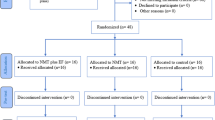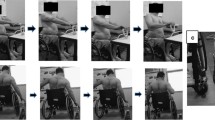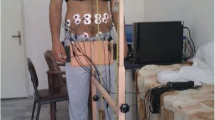Abstract
Effective stabilization is important to increase sports performance. Imbalanced spinal muscle responses between the left and right sides increase the risk of spinal buckling and microtrauma at the intervertebral joints. The purpose of this study was to confirm whether intensive unilateral neuromuscular training (IUNT) focusing on the non-dominant side of the low back improves balanced muscle responses and spinal stability. The IUNT group (n = 8) performed side bridge and quadruped exercises using their non-dominant trunk muscles for 8 weeks, while the control group (n = 8) performed their regular training. Before and after the training, motion-capture cameras measured trunk angular displacement, and electromyography recorded the activities of both multifidus muscles (L4–5) during unexpected sudden forward perturbation. After the training in the IUNT group, the difference in onset time between both sides decreased to approximately 120 % compared with that before the training. The asymmetry of muscle activities also decreased from 56 to 23 %. Moreover, the angular displacement on the sagittal plane decreased to approximately 35 % after the training. We expect that IUNT focused on the non-dominant side of the low back will be useful to improve balanced back muscle responses and spinal stability during sudden trunk perturbation.





Similar content being viewed by others
Abbreviations
- EMG:
-
Electromyographic
- IUNT:
-
Intensive unilateral neuromuscular training
References
Bazrgari B, Shirazi-Adl A, Lariviere C (2009) Trunk response analysis under sudden forward perturbations using a kinematics-driven model. J Biomech 42:1193–1200
Behm DG, Leonard AM, Young WB, Bonsey WAC, MacKinnon SN (2005) Trunk muscle electromyographic activity with unstable and unilateral exercises. J Strength Cond Res 19:193–201
Behm DG, Drinkwater EJ, Willardson JM, Cowley PM (2010) The use of instability to train the core musculature. Appl Physiol Nutr Metab 35:91–108
Beith ID, Harrison PJ (2004) Stretch reflexes in human abdominal muscles. Exp Brain Res 159:206–213
Bergmark A (1989) Stability of the lumbar spine—a study in mechanical engineering. Acta Orthop Scand 60:3–54
Boldori L, Da Solda M, Marelli A (1999) Anomalies of the trunk. An analysis of their prevalence in young athletes. Minerva Pediatr 51:259–264
Borghuis J, Hof AL, Lemmink KA (2008) The importance of sensory-motor control in providing core stability: implications for measurement and training. Sports Med 38:893–916
Callaghan JP, Gunning JL, McGill SM (1998) The relationship between lumbar spine load and muscle activity during extensor exercises. Phys Ther 78:8–18
Cholewicki J, McGill SM (1996) Mechanical stability of the in vivo lumbar spine: implications for injury and chronic low back pain. Clin Biomech 11:1–15
Gardner-Morse MG, Stokes IAF (1998) The effects of abdominal muscle coactivation on lumbar spine stability. Spine 23:86–91
Grabiner MD, Koh TJ, el Ghazawi A (1992) Decoupling of bilateral paraspinal excitation in subjects with low back pain. Spine 17:1219–1223
Hides J, Stanton W, Freke M, Wilson S, McMahon S, Richardson C (2008a) MRI study of the size, symmetry and function of the trunk muscles among elite cricketers with and without low back pain. Brit J Sport Med 42:809–813
Hides J, Stanton W, Mcmahon S, Sims K, Richardson C (2008b) Effect of stabilization training on multifidus muscle cross-sectional area among young elite cricketers with low back pain. J Orthop Sport Phys Ther 38:101–108
Hodges PW, Bui BH (1996) A comparison of computer-based methods for the determination of onset of muscle contraction using electromyography. Electroencephalogr Clin Neurophysiol 101:511–519
Hodges PW, Richardson CA (1996) Inefficient muscular stabilization of the lumbar spine associated with low back pain. A motor control evaluation of transversus abdominis. Spine 21:2640–2650
Hodges PW, Richardson CA (1997) Contraction of the abdominal muscles associated with movement of the lower limb. Phys Ther 77:132–142
Hodges P, Cresswell A, Thorstensson A (1999) Preparatory trunk motion accompanies rapid upper limb movement. Exp Brain Res 124:69–79
Köklü Y, Alemdaroğlu U, Koçak FÜ, Erol AE, Fındıkoğlu G (2011) Comparison of chosen physical fitness characteristics of Turkish professional basketball players by division and playing position. J Hum Kinet 30:99–106
Magnusson ML, Aleksiev A, Wilder DG, Pope MH, Spratt K, Lee SH, Goel VK, Weinstein JN (1996) Unexpected load and asymmetric posture as etiologic factors in low back pain. Eur Spine J 5:23–35
McGregor AH, Anderton L, Gedroyc WMW (2002) The trunk muscles of elite oarsmen. Brit J Sport Med 36:214–217
Millner PA, Dickson RA (1996) Idiopathic scoliosis: biomechanics and biology. Eur Spine J 5:362–373
Mullington CJ, Klungarvuth L, Catley M, McGregor AH, Strutton PH (2009) Trunk muscle responses following unpredictable loading of an abducted arm. Gait Posture 30:181–186
Myriknas SE, Beith ID, Harrison PJ (2000) Stretch reflexes in the rectus abdominis muscle in man. Exp Physiol 85:445–450
Okubo Y, Kaneoka K, Imai A, Shiina I, Tatsumura M, Izumi S, Miyakawa S (2010) Electromyographic analysis of transversus abdominis and lumbar multifidus using wire electrodes during lumbar stabilization exercises. J Orthop Sport Phys Ther 40:743–750
Panjabi MM (1992a) The stabilizing system of the spine. 1. Function, dysfunction, adaptation, and enhancement. J Spinal Disord 5:383–389
Panjabi MM (1992b) The stabilizing system of the spine. 2. Neutral zone and instability hypothesis. J Spinal Disord 5:390–397
Panjabi M, Abumi K, Duranceau J, Oxland T (1989) Spinal stability and intersegmental muscle forces—a biomechanical model. Spine 14:194–200
Pedersen MT, Essendrop M, Skotte JH, Jorgensen K, Schibye B, Fallentin N (2007) Back muscle response to sudden trunk loading can be modified by training among healthcare workers. Spine 32:1454–1460
Reeves NP, Cholewicki J, Silfies SP (2006) Muscle activation imbalance and low-back injury in varsity athletes. J Electromyogr Kines 16:264–272
Renkawitz T, Boluki D, Grifka J (2006) The association of low back pain, neuromuscular imbalance, and trunk extension strength in athletes. Spine J 6:673–683
Renkawitz T, Boluki D, Linhardt O, Grifka J (2007) Neuromuscular imbalances of the lower back in tennis players–the effects of a back exercise program. Sportverletz Sportsc 21:23–28
Souza GM, Baker LL, Powers CM (2001) Electromyographic activity of selected trunk muscles during dynamic spine stabilization exercises. Arch Phys Med Rehabil 82:1551–1557
Stokes IAF, Iatridis JC (2004) Mechanical conditions that accelerate intervertebral disc degeneration: overload versus immobilization. Spine 29:2724–2732
Strutton PH, Mullington CJ, Klungarvuth L, Catley M, McGregor AH (2009) Trunk muscle responses following unpredictable loading of an abducted arm. Gait Posture 30:181–186
Vera-Garcia FJ, Brown SHM, Gray JR, McGill SM (2006) Effects of different levels of torso coactivation on trunk muscular and kinematic responses to posteriorly applied sudden loads. Clin Biomech 21:443–455
Wilke HJ, Wolf S, Claes LE, Arand M, Wiesend A (1995) Stability increase of the lumbar spine with different muscle groups—a biomechanical in vitro study. Spine 20:192–198
Acknowledgments
The authors thank all individuals who kindly participated in the training. The authors also thank Mr. Hyo Young Pyeon for practical assistance during the training period. This study was supported by a Korea University grant.
Conflict of interest
There are no conflicts of interest to declare.
Author information
Authors and Affiliations
Corresponding author
Additional information
Communicated by Dick F. Stegeman.
Rights and permissions
About this article
Cite this article
Kim, Y., Son, J. & Yoon, B. Intensive unilateral neuromuscular training on non-dominant side of low back improves balanced muscle response and spinal stability. Eur J Appl Physiol 113, 997–1004 (2013). https://doi.org/10.1007/s00421-012-2513-7
Received:
Accepted:
Published:
Issue Date:
DOI: https://doi.org/10.1007/s00421-012-2513-7




